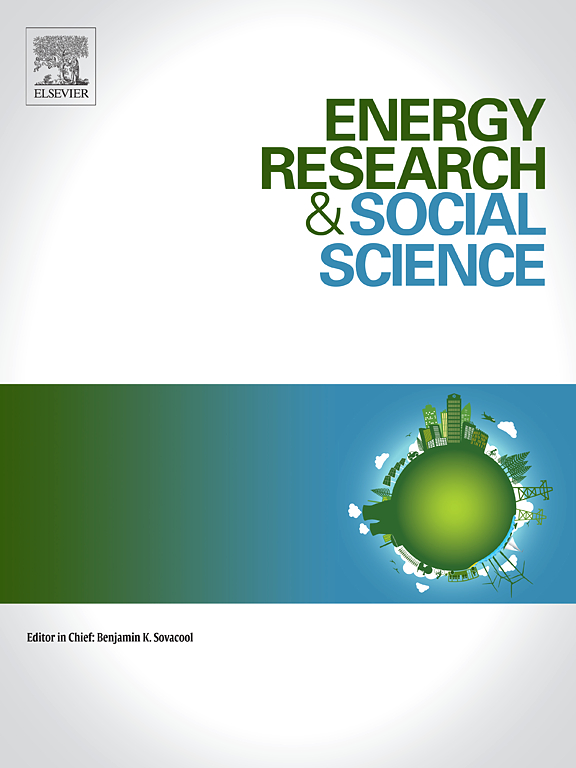Regional preconditions and sustainability transition pathways: Insights from circular, bio-based and resource-efficient building material innovations in Vietnam
IF 6.9
2区 经济学
Q1 ENVIRONMENTAL STUDIES
引用次数: 0
Abstract
High urbanization dynamics and major construction activities in its cities have highlighted the need for more sustainable building practices in the Global South. While local innovation processes take place at the grassroots level, they often struggle to break through. The study follows the main research question of how regional preconditions characterize the innovation, diffusion and transition dynamics of different “green” building material technologies in different spatial settings of Vietnam. We seek to understand the relations between local socio-technical configurations and the diversity of innovations and potential transition pathways. This is particularly relevant for southern contexts where scholars have noted a greater regime heterogeneity. Instead of black boxing “green innovations” and “the Global South”, we study place- and technology-specific effects of regional configurations as preconditions for the development and diffusion of circular, bio-based and more resource-efficient building material innovations in three regions of Vietnam (Hanoi, Da Nang and Ho Chi Minh City). To understand the region- and technology-specific characteristics, we build a framework that differentiates three main dimensions of regional preconditions, institutional factors, the technical specialisation and material flows, and thirdly, market networks and demand. The results show that some preconditions vary for different material innovations and regions while others take effect across technologies, regions or scales. This creates highly differentiated opportunity-spaces for different innovations that can be addressed with targeted and diversified transition strategies that address (trans) regional preconditions on different scales and for different emergent technologies and regions.
区域先决条件和可持续性过渡途径:来自越南循环、生物基和资源节约型建筑材料创新的见解
其城市的高城市化动态和主要建筑活动突出了全球南方对更可持续建筑实践的需求。虽然地方创新过程发生在基层,但往往难以突破。该研究遵循了区域先决条件如何表征越南不同空间环境中不同“绿色”建筑材料技术的创新、扩散和过渡动态的主要研究问题。我们试图了解当地社会技术配置与创新多样性和潜在过渡途径之间的关系。这与南方的情况特别相关,学者们注意到那里的政权异质性更大。我们研究的不是“绿色创新”和“全球南方”的黑箱,而是在越南的三个地区(河内、岘港和胡志明市)研究区域配置对特定地点和技术的影响,作为循环、生物基和更节约资源的建筑材料创新发展和扩散的先决条件。为了理解区域和技术的特定特征,我们建立了一个框架,该框架区分了三个主要维度:区域先决条件、制度因素、技术专业化和物质流动,以及市场网络和需求。研究结果表明,不同的材料创新和区域存在不同的前提条件,而其他前提条件则在不同的技术、区域或尺度上发挥作用。这为不同的创新创造了高度差异化的机会空间,这些创新可以通过有针对性和多样化的过渡战略来解决,这些战略可以解决不同规模和不同新兴技术和地区的(跨)区域先决条件。
本文章由计算机程序翻译,如有差异,请以英文原文为准。
求助全文
约1分钟内获得全文
求助全文
来源期刊

Energy Research & Social Science
ENVIRONMENTAL STUDIES-
CiteScore
14.00
自引率
16.40%
发文量
441
审稿时长
55 days
期刊介绍:
Energy Research & Social Science (ERSS) is a peer-reviewed international journal that publishes original research and review articles examining the relationship between energy systems and society. ERSS covers a range of topics revolving around the intersection of energy technologies, fuels, and resources on one side and social processes and influences - including communities of energy users, people affected by energy production, social institutions, customs, traditions, behaviors, and policies - on the other. Put another way, ERSS investigates the social system surrounding energy technology and hardware. ERSS is relevant for energy practitioners, researchers interested in the social aspects of energy production or use, and policymakers.
Energy Research & Social Science (ERSS) provides an interdisciplinary forum to discuss how social and technical issues related to energy production and consumption interact. Energy production, distribution, and consumption all have both technical and human components, and the latter involves the human causes and consequences of energy-related activities and processes as well as social structures that shape how people interact with energy systems. Energy analysis, therefore, needs to look beyond the dimensions of technology and economics to include these social and human elements.
 求助内容:
求助内容: 应助结果提醒方式:
应助结果提醒方式:


